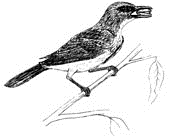Vertebrate Pest Conference Proceedings collection
Date of this Version
1996
Document Type
Article
Citation
Published in Proceedings: Seventeenth Vertebrate Pest Conference … 1996, ed. Robert M. Timm & A. Charles Crabb (University of California, Davis, 1996).
Abstract
The occurrence of plague (Yersinia pestic) at Ice House Reservoir in 1994 and 1995 was characteristic of widespread epizootics in high use recreational areas of California. Staff of the Vector-Borne Disease Section investigated these epizootics and found dense populations of plague susceptible California ground squirrels (Spermophilus beecheyi) with high numbers of fleas, primarily Diamanus montanus, the most important plague vector. This combination indicated a high risk of plague exposure to campground users. A non-fatal human case of plague, contracted at Mountain Camp II, was reported after the initial epizootic investigation. The patient's exposure occurred prior to the reporting of the epizootic die-off among the California ground squirrels. The plague investigation included direct observations, animal trapping, and laboratory testing of rodent carcasses, sera, and fleas. Plague management and prevention included flea control with 2% Diazinon dust and rodent population reduction using 1% zinc phosphide treated grain. Evaluation of the 1994 applications indicated a successful reduction of rodents and fleas. However, the need for an ongoing management program was emphasized in 1995 when the plague epizootic continued. Intrusion of plague infected rodents and their fleas necessitated a 1995 treatment in the four campgrounds involved.
Included in
Animal Sciences Commons, Bioresource and Agricultural Engineering Commons, Environmental Engineering Commons


Comments
Copyright © 1996 (where applicable) by the Vertebrate Pest Council of the Vertebrate Pest Conference. Used by permission.